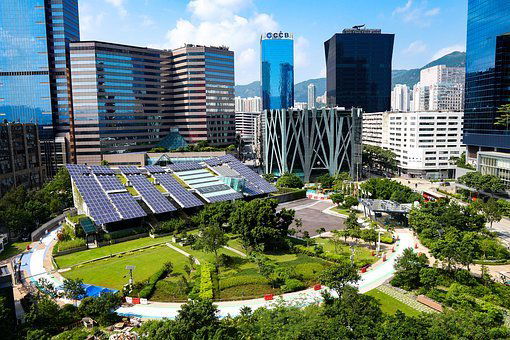Greening the Construction Industry

Green Construction is here to stay-
Green construction aims to eliminate, or at least reduce negative environmental effects on the design, construction and operation phase of buildings. It’s also known as Sustainable Construction. Its aim is not only to reduce environmental damage, but to create buildings that have a positive impact on the environment and society as a whole.
Construction is one of the largest contributors to greenhouse gas emissions. Buildings account for approximately 40% of all CO2 emissions in developed countries, and are responsible for 18% of total emissions globally.
Energy consumption is thus a major root consideration over the lifespan of a building- from design to ultimate demolition.
Countries with large living natural resources- Trees and arable crops, are in the forefront of green or sustainable construction, and this applies just as much to the interior of a building as the exterior.
Canada is a good example of such a country. Its green building industry now generates more than $27.2 Billion, 10% greater than all the other hard hat industries combined, (Forestry, Mining and resource extraction). This is often cited as proof that green building is beneficial to both individuals and wider society.
Benefits of Green Construction are Economic, social and environmental.
- Economic: Initial costs of green construction are usually higher than conventional construction. The extra cost is usually in the design and construction phase, though some studies show there is actually little or no difference in costs. The accountant in us tells us it is worth investing a fraction more in the early stages because we gain once the building is up and running. Interestingly, studies show that not only houses but buildings in general built using green techniques achieve higher rents and property prices. They have an additional desirability factor.
- Social: The social benefits of green construction are broader than individual economic project metrics. Nations are now including sustainability as government policy. The Irish government for instance, promotes Project Ireland 2040, an infrastructure plan for the next 20 years. The plan initially included a €500 million climate action fund for green initiatives, and this fund seems to be expanding with each annual budget. Green construction is an important part of the plan with strategic points including:
- Investment in energy efficiency, with 45,000 upgrades to homes
- Investment in the energy efficiency of existing commercial and public building stock
- Supports for changing out oil-fired boilers to heat pumps, along with the provision of roof based solar energy installations.
The full roll-out of the new support schemes for renewable construction and operation of energy efficient buildings is active worldwide now. These schemes are designed to give more comfortable buildings, less draughty, cheaper to heat units, with better air quality within and a consequent quality increase in environmental factors. These include positive Visual Amenity, Atmospheric Quality and Energy Generation upgrades.
- Environmental: Construction itself has a significant impact on the environment. This means that any improvement in construction materials and advanced techniques can have an impact far beyond the sector. Merely changing one material for another may not give an overall improvement, e.g. changing copper pipe for plastic pipe. More important will be to change the fundamental material for a low energy, stable, ultimately biodegradable material. One such material is a plasterboard coming on stream made from corn fibers pressed between paper outer surfaces, completely biodegradable and non-toxic and the waste or off-cuts can even be used as a fertiliser!
Another such product is an ultra-breathable lime plaster that regulates moisture and helps reduce problems with condensation and mould, providing high thermal performance, moisture regulation and acoustic insulation for better living comfort.
Sustainably sourced timber is another source, as is bamboo, mycelium (a kind of fungus), and even classic linoleum
Considered together, all these upgrades will bring us closer to the world we wish for
In summary- Basics of Green Construction:
Biodegradable Materials:
This means nothing ultimately goes to landfill or rubbish tip. We will then look at that skip with new eyes.
Solar Energy:
Solar power is a clean energy source and is becoming cheaper and more efficient every year. The source of power is abundant because the only fuel you need is the sun in the sky. It can power your house and heat your water. Solar panels provide a clean and independent source of power with no running costs and negligible maintenance issues
Technology Efficiency:
Constructing a building requires a lot of energy. This is usually in the form of fossil fuel usage, releasing CO2 and other emissions as a by-product. If you make this process more efficient you significantly reduce the environmental impact per building. Now add efficient running infrastructure and you get less running cost and a better space for us all.
